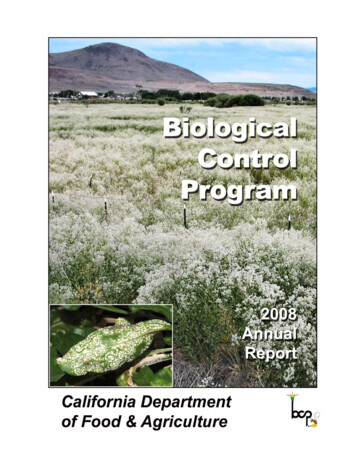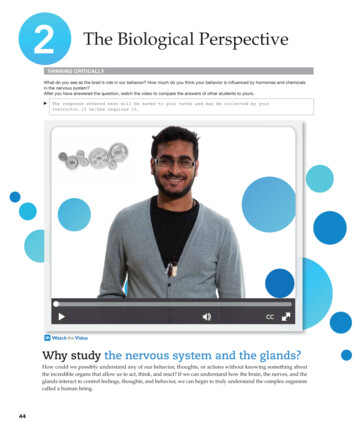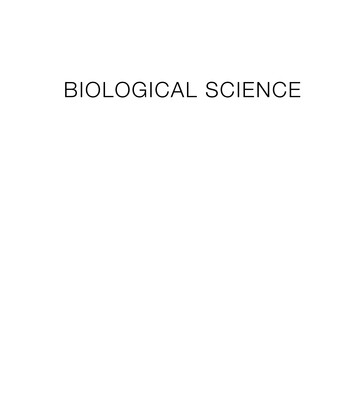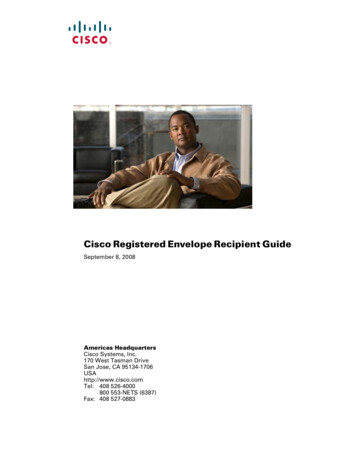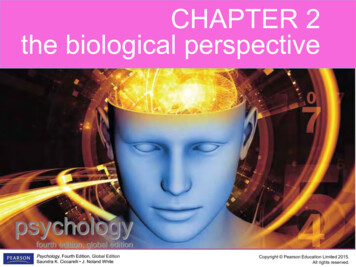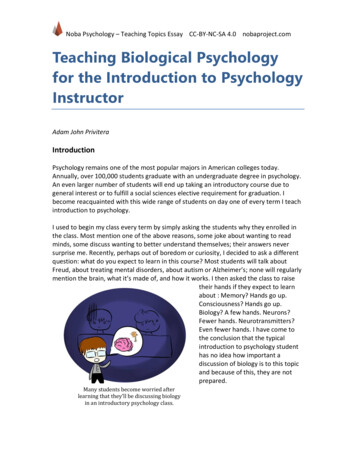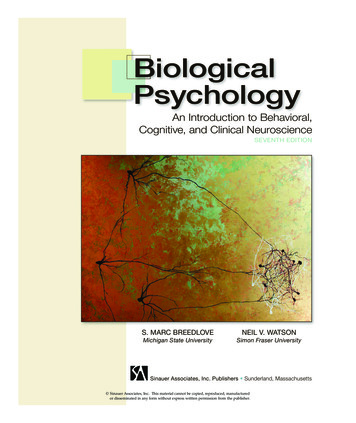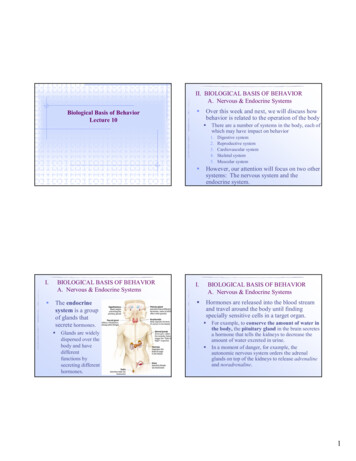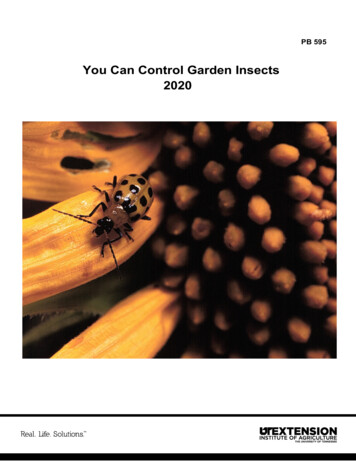
Transcription
The First Registered Biological Control Productfor Turf Disease: Bio-Trek 22Gby G. E. Harman andCornell UniversityC-TLoDiseases of golf green turfgrasses cause unsightlyspots and discolorations that are undesirable andunacceptable to golf course managers and thegolfing public. The development of highly effective turfgrass fungicides has revolutionizeddisease management of turf, especially on golfcourses. However, high levels of fungicides arerequired. Fungicide usage on golf courses, andgreens especially, is probably the most intenselarge-scale application per unit area in the US.Fungicide sales are about 400 million annuallyin the United States, and about 100 million isspent on turf applications, with 90% of this usedon golf courses.There are disadvantages to this heavy use. The mostobvious of these is the frequent exposure of workersand users of managed turf areas to fungicides. Inaddition, there is the possibility for contaminationof soil and water in and around golf courses andother areas of managed turf. This possibility of contamination is a matter of concern because much ofthe treated turf is in urban areas with high adjacenthuman populations. Wildlife may also be affectedby contamination of soil or water.In addition, a large and diverse population of soilmicroorganisms is important to plant health.Typically, populations of fungi and bacteria(including actinomycetes) predominate in soils.Generally, the greater the diversity and activity ofthese soil microorganisms, the greater the overallhealth and fertility of the soil. However, repeatedfungicide applications can severely impair microbial diversity and activity in soils of golf coursesand other intensively managed turf areas. In ourpreliminary studies, we found one area of golfcourse turf in which no fungi could be detectedin soil or roots. This is very unusual, and asidefrom golf turf ecosystems we know of no otherTurfGrass TRENDS 1775situation where such a drastic reduction infungal populations has occurred. Specific undesirable consequences of this alteration of soilmicroflora are as follows: It is not uncommon (nearly 100 examples can bedocumented) to see increases in certain diseases following fungicide application for control of otherdisease This increase is due primarily to detrimental effects on nontarget organisms. In soils where fungicides have not been appliedat high rates, the diverse microbial communitiespresent frequently provide a substantial measure ofbiological control. The increase in disease noted inthe preceding paragraph probably is due to destruction of nontarget beneficial microorganisms. Heavy fungicide use encourages the development of resistant populations of plant pathogens.There are numerous reports on the developmentof pathogen populations that are resistant tochemical fungicides, including cases where resistance was observed on golf courses. This would beexpected given the heavy fungicide applicationsmade to greens.The development of Bio-Trek 22GClearly, alternatives to chemical pesticides areneeded for turf disease management and otherapplications. The authors, in conjunction withDr. E. B. Nelson, have been developing biologicalalternatives to chemical pesticides for turf diseasemanagement for several years, especially beneficialfungi in the genus Trichoderma. These fungi arepresent in nearly all soils and no doubt contribute toa lessening of disease where they occur. However,their numbers and physiological types are normallyinsufficient to give high levels of disease control.T Street N W Washington, D C 2 0 0 0 9 - 7 1 2 4Phone: 202-483-TURF Fax: 2 0 2 - 4 8 3 - 5 7 9 7 Internet: 76517.2451@CompuServe.com
About 10 years ago, we produced strain 1295-22(also known as KRL-AG2) of T harzianum, andthis organism seemed to have a number of usefulattributes. Not only did it have the ability tocontrol disease when properly used, but it also wasextremely efficient in colonizing roots. Once established on roots, it persisted for the lifetime ofannual crops, and continued to colonize plant rootsas they grew. Therefore, all parts of the root systemwere colonized. On perennial plants, such as turfgrass, the fungus survived on roots even over thecold winters of upstate New York. As a consequence, application of the fungus may substantiallyincrease crop yield and increase root growth.This fungus, and formulations based upon it,recently were registered with the USEnvironmental Protection Agency for plant diseasecontrol. It has received an exemption from tolerance for use on food crops, since toxicology testinghas shown no observable toxic or pathogenic effectsupon plants, mammals, or birds.Products based on Trichoderma harzianum aremanufactured by TGT Inc, Geneva, NY [Editorsnote: no relation to TurfGrass TRENDS, which isfrequently abbreviated "TGT"] and marketed forturf applications as Bio-Trek 22G by Wilbur-EllisCo, Fresno, CA. Bio-Trek is the first EPA- regis-tered biological disease control agent that is available commercially for turfgrass disease control inthe United States.The following is a description of tests and uses ofBio-Trek 22G, and an assessment of our expectations for future developments. It is also a story ofthe translation of basic biological findings at a university into commercial applications.We first tested a granular formulation verysimilar to Bio-Trek 22G in 1990 and found thatit reduced dollar spot incidence. Trials since thatdate in the Northeast, Midwest, and Far Westhave demonstrated continued efficacy. A criticalaspect of this products efficacy is the ability ofT. harzianum to establish itself at effective levelson turfgrass roots. We expect that it can be established by one or two applications in the springand that it will then persist over the followinggrowing season. Data on establishment from our1994 trials are given in Fig. 1. Two applicationsearly in the year were sufficient to provide highlevels of colonization of soil and creeping bentgrass roots that persisted at high levelsthroughout the year. We sampled this same areain August, 1995, and found T. harzianum atlevels about 10 times higher than in adjacent turfareas. This indicates survival times of theFig. 1. Colonization of roots and soil ofcreeping bentgrass in a replicated trial on acreeping bentgrass golf green. Bio-Trek 22Gwas applied on the dates indicated, androot/soil samples were taken at monthlyintervals. Note that Trichoderma persisted ata high level throughout the year.The y axis isa log scale, so each number given represents a10-fold increase in Trichoderma levels. Forexample, log 5 represents 100,000 viablepropagules of the fungus, and log 6 represents1,000,000. The increase in Trichoderma levelsin the nontreated plots over time probably is aconsequence of spread of T. harzianum fromadjacent treated plots. Data is from Lo, C-T,Nelson, E. B., and Harman, G. E. 1996.Improving the biocontrol efficacy ofTrichoderma harzianum 1295-22 for controlling foliar phases of turf diseases by sprayapplications. Plant Dis. (in preparation)
biocontrol agent on turf roots for more than a year.However, in 1995, T. harzianum populations haddropped to levels necessitating another application.The cultivars used in these field trials were Pencrossand Cobra.These data indicate that Bio-Trek 22G can be auseful product for turf disease management.Its advantages are: It provides a means of establishing T. harzianum insoil and on roots, thereby providing a means ofrestoring beneficial microbes in turf soils.This establishment of a biocontrol fungus resultedin reduced severity of several diseases. Dollar spotdata are shown for 1993 and 1994 (Fig. 2), while It reduces the level of disease organisms in soil,control of brown patch and Pythium root rot are and so initial disease levels will be lower once theshown for 1994 (Fig. 3). In 1993, brown patch and biocontrol fungus is established.Pythium were not evident. It is nontoxic and nonpolluting, but has goodAnother benefit of Bio-Trek 22G was also evident in persistence, so its beneficial effects can persist overour trials. The product was applied in June and July, an extended time period.but in November the treated areas were easily recognizable: the plots that had received the granular for- Based on our experience with both turf and othermulation of T. harzianum were greener than adjacent crops, it can enhance root health and growth.plots. This turf had not been fertilized after mid- However, there are some things that this biologicalsummer, so the enhanced color may have reflected agent cannot do, and these limitations must be recthe ability of a more vigorous root system to provide ognized as well. These are:better uptake of nutrients. This improved color persisted into 1995, and was still evident in August of Bio-Trek 22G is applied to soil, and the beneficialthat year, even though no additional T. harzianum fungus becomes established in roots and soil.had been applied to those areas.Therefore, it cannot control foliar diseases, or foliarFig. 2. Disease progress of dollar spot in replicated trials in 1993 and 1994 in the presence and absence of Bio-Trek22G. Lines were fitted using the general models program (SAS, Cary, NC). Disease severity is defined as the percentage of total plot area with diseased turf. The differences between treatments and time required to reach specificdisease levels were significantly different. These data are used with permission of the American PhytopathologicalSociety, and are from Lo, C-T, Nelson, E. B., and Harman, G. E. 1996. Control of turfgrass diseases with arhizosphere competent strain of Trichoderma harzianum. Plant Dis. (accepted for publication with revision).
Pythium root rotBrown patchFig. 3. Incidence of Pythium root rot and brown patch in replicated plots on a creeping bentgrass green after notreatment and treatment with Bio-Trek 22G. Disease severity is defined as the percentage of total plot area withdiseased turf. Numbers followed by dissimilar letters are significandy different for the date shown. Data is from Lo,C-T, Nelson, E. B., and Harman, G. E. 1996. Improving the biocontrol efficacy of Trichoderma harzianum 1295-22for controlling foliar phases of turf diseases by spray applications. Plant Dis. (in preparation).Table 1. Fungicides compatible or incompatible with Bio-Trek 22GCompatible fungicidesChloroneb(e.g. Chloroneb, Terreneb)Etridiazole(e.g. Koban, Terrazole)Iprodione (e.g. Chipco 26019)Mancozeb (e.g. Fore)Metalaxyl (e.g. Subdue)Quitozene(e.g. PCNB, Terrachlor)Triadimefon (e.g. Bayleton)Vinclozolin (e.g. Vorlan, Touche, Curalan)Fosetyl A1 (e.g. (Aliette)phases of soilborne diseases such as dollar spot.Foliar diseases spread rapidly and are favored by frequent mowing and watering, so chemical fungicidesprays will have to be used to control them. T. harzianum is a living organism that mustbecome established in soil and on roots of turf tobe effective. See the Field Tips section furtherbelow for some guidelines to accomplish this.Incompatible fungicidesBenomyl (e.g. Tersan 1991)Propiconazole (Banner)Questionable, or no dataAnilazene (e.g. Dryene)Chlorothalonil (e.g. Daconil 2787)Fenarimol (e.g. Rubigan, Lesco Twosome)Thiram (e.g. Spotrete)Thiophanate methyl (e.g. Clearys 3336,Fungo)However, some chemical fungicides are lethal toT. harzianum, and if possible they should not beused in conjunction with Bio-Trek 22G. A list offungicides and their compatibility/incompatibilitywith T. harzianum is given in Table 1. In addition, like all living organisms, T. harzianumwill be more active under some conditions thanothers. In particular, it will not be effective when
soil temperatures are below 50 F. However, it survives on roots and becomes active when soils warm.It is most effective at soil temperatures between70 F and 90 F.The first commercial T. harzianum products wereavailable for sale in 1995. These were granular formulations designed for broadcast application. Efforts toevaluate these products in our lab were primarily concerned with assessing the level of establishment of thefungus on roots. Roots from sites around the USAindicated that establishment did occur.There were some problems, however. First, theproduct was formulated for multiple uses and wasquite dusty. This made broadcast application difficult. Second, while the product was quite effectivefor many applications, we found that transfer of thefungus from the granule to the roots was not aseffective with broadcast application as it was whenthe granules were directly incorporated into soil.As a consequence, even though the fungus didbecome established, in some cases its populationlevel remained at suboptimal levels.Therefore, in 1996, TGT Inc. will formulate BioTrek 22G specifically for broadcast application toturf, and its properties will be different from thegeneral use material. The turf product will have alarger particle size to facilitate broadcast application, the dust level will be substantially reduced,and its concentration of 27 harzianum will behigher to enhance root and soil colonization. Weexpect that this product will be effective for itsintended uses.The development of futuretechnologiesBio-Trek 22G is highly useful: but, as noted above,it has limitations. Most notably, since the productis applied to the soil and the fungus is located in theroot-soil zone, it cannot protect against foliarpathogens. With this factor in mind, we havebegun testing a spray formulation that consists primarily of conidia (spores) of the fungus. The firsttrials, conducted in 1994, were successful. Levelsof control were equivalent to standard chemicalfungicides for brown patch, dollar spot, andPythium root rot and blight (Fig. 4) when a surfactant (Triton X-100) was included in the spraymixture. When disease pressure was light, amonthly spray schedule sufficed, but applicationshad to be increased to once a week when diseasewas more severe. As a bonus, this spray applicationresulted in root colonization that was nearly aseffective as the granular product. These results givepromise of a largely biological turf managementoption, but problems remain.Difficulties were evident when we attempted toapply the 1994 findings to commercial golfcourse trials in 1995. Little or no efficacy wasobtained; this problem appears at least in part tobe related to toxic fungicide residues in the spraytank. As the biocontrol agent was suspended intanks that have been used repeatedly to applyfungicides, some factor, probably low levels ofresidual pesticides, prevented spores of the fungusfrom germinating.Other problems also remain. Technologies forlarge-scale manufacture of sprayable biological formulations at a reasonable cost are not fully developed, and so only prototype preparations are available now. Further, 27 harzianum is useful only as apreventative application and cannot cure existingdisease. Of course, like all materials available to golfcourse managers, this fungus will not be effectiveagainst all diseases. These last two factors indicate aneed for the development of integrated biologicalchemical control systems that reduce the need forchemical fungicides.Research efforts at Cornell University will focuson the development of spray formulations forcommercial golf courses. We will determinewhich chemicals cannot be used in sprayersemployed for T. harzianum application, andattempt to devise methods for removal of themost important toxic materials. We anticipatethat only a few of the incompatible materials inTable 1 will cause most of the problems. At least,we should be able to make recommendationsregarding fungicides to be avoided.
Fig. 4. Severity of dollar spot, brown patch, or Pythium root rot in replicated plots on a creeping bentgrass green afterno treatment, treatment with a standard fungicide, or treatment with sprays containing spores of 77 harzianum andTriton X-100. Disease severity is defined as the percentage of total plot area with diseased turf. 77 harzianum treatmentswere applied monthly until July 26, and thereafter weekly. In all cases, the disease severity in nontreated plots wassignificantly different from treated plots, but fungicide and 77 harzianum treatments were not significantly different.Data is from Lo, C-T, Nelson, E. B., and Harman, G. E. 1996. Improving the biocontrol efficacy of Trichodermaharzianum 1295-22 for controlling foliar phases of turf diseases by spray applications. Plant Dis. (in preparation).In summaryWe will also test prototype commercial productsand develop full dosage information for them.And we will determine spray adjuvants, primarilyspreader/sticker materials, that provide the bestresults with 77 harzianum.With this information, we will develop recommendations for using 77 harzianum that will be testedon golf courses and other commercial sites.In addition, we will investigate development ofintegrated sprays that combine reduced rates of acompatible fungicide with the beneficial fungus.An integrated biological-chemical system maylessen fungicide use, provide some of the curativeability of fungicides, result in root colonization of77 harzianum., establish diverse microbial soil populations that promote plant health, and be competitively priced. We hope to begin research scaletrials of both full biological and biological-chemical control systems this summer.The first registered biological control productBio-Trek 22G, for the control of turf diseases is nowavailable. This product contains a strain of the beneficial soil fungus, Trichoderma harzianum,, and is designedfor broadcast application to turf. The fungus becomesestablished on the roots and in the soil of turf and persists for months after application. Once establishmentoccurs, it can become a component of a healthy soilmicrobial community and reduce soilborne disease.It cannot control foliar diseases, however, and thereforemust be used in conjunction with compatiblefungicides. We anticipate that Bio-Trek 22G will be thefirst of several biological products for turf diseasecontrol. Other biological and integrated biologicalchemical control products will be manufactured byTGT that will extend the usefulness of Bio-Trek 22G.Trichoderma - is a genus of beneficial fungus that iscommon in soils. There are a number of types and kinds.Trichoderma harzianum (T harzianum ) strain 1295-22 is aselection of this fungus that is particularly able to colonizeplant roots. It is formulated as Bio-Trek 22G for diseasesuppression in golf course management.Nontaiget organisms - These are living components of the turf-soilecosystem that, while not intended as targets for pesticides, can beadversely affected, sometimes even killed, by fungicide applications.
Field tipsDr. Harman is a cofounder of TGT Inc., the company thatproduces Bio-Trek 22G.1. For initial establishment of T. harzianum we suggest two applications of Bio-Trek 22G,four to six weeks apart during the first spring.These applications should be made as thesoils warm in the spring, preferably after theirtemperature reaches 50 EChaur-Tsuen Lo is an Associate Plant Pathologist in theDepartment of Plant Pathology at the TaiwanAgricultural Research Institute, Taichung, Taiwan,Republic of China. His major responsibilities are in biocontrol of plant diseases. He is currently completing hisPh.D. degree at Cornell University under the direction ofDr. Harman and Dr. Eric Nelson in the area of the biological control of turf diseases. This is his first contribution to TurfGrass TRENDS .2. Another application should also be made asthe soils begin to cool in the autumn, againpreferably while they are warm (above 60 F).3. Single applications in spring and fallshould suffice thereafter.4. As an alternative to broadcast applicationsof Bio-Trek 22G, we anticipate that it will beeffective if incorporated into new golf greensat the time of planting.5. If possible, only compatible fungicidesfrom the list on Table 1 should be used withBio-Trek 22G; and they should be appliedonly one to two weeks after the application ofBio-Trek 22G (so that the fungicide is notapplied directly to Bio-Trek 22G).6. Holding pH values below neutral (7.0) isbest for Trichoderma.Gary E. Harman is a Professor in the Departments ofHorticultural Sciences and Plant Pathology at CornellUniversity's New York State Agricultural ExperimentStation, Geneva, NY. He has a B.S. from Colorado StateUniversity and a Ph.D. from Oregon State University. Dr.Harman has devoted much of his career to the development of biological alternatives to chemical pesticides for avariety of applications, including perennial, row, and greenhouse crops, as well as turf. He has focused recently onidentifying genes and gene products that may be useful inagriculture, and developing biocontrol systems based onbeneficial fungi. This is his first contribution toTurfGrass TRENDS .Ask the Expert:Questions regardingBio-Trek 22GT. harzianumBy G. E. HarmanCornell UniversityQuestion: How does T. harzianum control disease?Answer: This biocontrol fungus probably hasseveral modes of action. Physically, it coils aroundfungi and digests their cell walls. In addition, pathogenic fungi attack plants when nutrients from theplants leak into soil, stimulating fungal growth.T. harzianum appear to limit this nutrient leakage,thereby reducing fungal infection. Other mechanisms also may be operating, including simply colonizing roots sufficiently that other fungi have difficulty becoming established on or in roots.Question: If I have questions about Bio-Trek 22G,who can I ask? Also, if I wonder whether it hasbecome established in my turf, how can I test this?Answer: TGT Inc. is strongly interested in yourexperiences with Bio-Trek 22G in 1996.Questions on its use can be addressed toDr. Christopher Hayes, Director of Research andProduct Development, TGT Inc., Geneva,
of soil and water in and around golf courses and other areas of managed turf. This possibility of con-tamination is a matter of concern because much of the treated turf is in urban areas with high adjacent human populations. Wildlife may also be affected by contamination of soil or water. In addition

